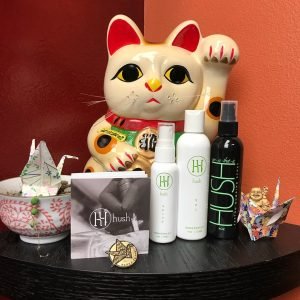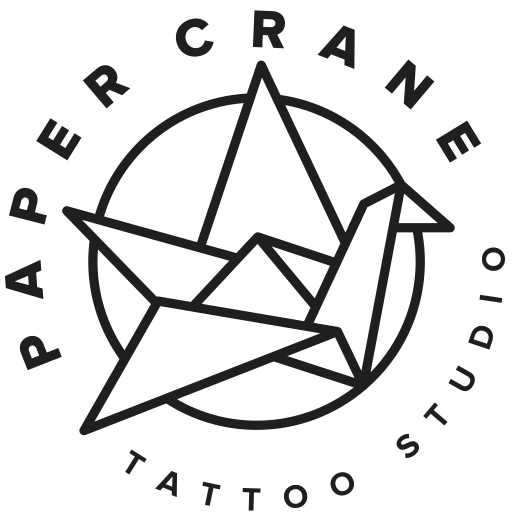How Much Will My New Tattoo Hurt?
For many tattoo enthusiasts, the pain of new ink is part of the ritual. While some find it to be almost as addicting as the finished product itself, at Paper Crane we know that for some clients there is a lot of apprehension about just how much that tattoo needle might hurt. There are numerous factors to consider when it comes to pain, so we're sharing our industry insight to help you decide how much you can handle for your next session.

Pain Factor 1: The Tattoo Needle
If you've checked out our blog on tattoo needles, you know that your tattoo artist is actually using multiple needles (called "pins") grouped together to achieve a certain stylistic goal.Typically, the smaller the pin grouping, the more painful the tattooing experience. Most clients agree that the outlining of a tattoo is the most painful aspect. This is because a liner features as few as three pins--and even when it has more, the pins are grouped very tightly together.With larger or more spread-out groupings, the pressure is distributed over a larger section of skin, which can result in less pain; this is true in the case of a magnum needle, as it features as many as forty-nine pins widely spaced out. Conversely, with a liner needle, the pressure is being applied intently to a smaller area, which equals sharper, more intense pain.Interested in a fine-line or single-needle tattoo? Be prepared for some next-level ouchiness, depending on where you're placing your new piece.
Pain Factor 2: The Intensity of Shading
We sometimes hear clients describe the pain from outlining as "cutting" and the pain from shading as "burning." In the case of a tattoo that features some simple black-and-grey shading, it may very well be your experience that the outline is the most painful part of the session.But consider the depth of shading that goes into a photorealistic rose or an illustrative owl: To capture the nuanced complexities that make these tattoos pop, an artist must go over the same patch of skin numerous times. This is equally true of black-and-grey and full color, as both approaches require careful blending during multiple passes.A tattoo is an open wound, as the needle deposits ink by piercing the skin. Over the course of a two-hour session that involves heavy shading, an artist will apply layer upon layer of ink to the same patch of skin. That means the tattoo needle will be continuously poking your open wound. So although shading might not initially hurt as much as lining, the continued work on tender skin can prove to be pretty painful!
Pain Factor 3: The Heaviness of Your Artist's Hand
At Paper Crane, we're very proud of that fact that our artists are among the best in the industry. Our seasoned professionals know exactly the right amount of pressure to apply when tattooing to ensure that your tattoo looks as beautiful as you're imagining.Many tattoo artists struggle with this crucial aspect of tattooing. A heavy-handed artist is one who applies too much pressure. This results in the needle going too deep, which is considerably more painful than when the proper layer of your dermis is pierced. Moreover, it can result in displaced ink and shadows.It's important to note that there are a lot of reasons that a tattoo can scar or otherwise not heal well, including improper aftercare. You can read our tips on proper aftercare here. When you work with an artist at Paper Crane, you can rest assured that heavy-handedness won't be an issue.
Pain Factor 4: Tattoo Placement
Truth time: Some tattoo placements just hurt more than others. You may really want to get some sacred geometry tattooed on your throat--but if you're nervous about the pain, you should know it's among the most sensitive areas on your body, whereas your outer arm is much less sensitive.Although everyone's body is different, this is a general breakdown of what to expect with tattoo placement:
- Worst Pain Ever: Head, face, throat, spine, inner upper arm, wrist, hand, groin, inner thigh, knee cap, behind the knee, ankle, foot
- Still Pretty Awful: Neck, collarbone, chest, rib cage, stomach, torso, lower back, inner elbow, inner forearm
- Not Too Bad: Hip, outer thigh, mid back
- Least Pain Possible: Shoulder, upper back, outer upper arm, outer forearm, butt
Pain Factor 5: Topical Anesthetics
So you really want sacred geometry on your throat, huh? Well, even if you're terrified of the pain, there's hope! We proudly carry HUSH topical anesthetic sprays and gels to help you manage pain. Sprays can be applied by your artist during your session to instantly numb your skin. HUSH's long-lasting gel must be applied an hour before your session--and it can only be used after your first session is completed, as it can potentially interfere with the ink from our transfer paper."I always encourage my clients to feel the tattoo in its full experience at least once," shop founder and senior artist Mikey Vigilante says. "But after a two hours of tattooing--especially on a sensitive area--your body can get overwhelmed. HUSH is a great alternative to splitting a tattoo into multiple sessions." Everyone has different sensitive spots, so your experience might be totally at odds with these insights. In any case, we hope that we've relieved some of your apprehension--and if not, we'd be happy to talk more with you about HUSH or to suggest alternative placements for your new ink.We'll leave you with this final thought from Mikey: "It's important to ultimately choose your tattoo location without making pain your top consideration. While a tattoo can be intense, we will help you get through it. Choose a place that you will be happy with for a lifetime, as the pain is only temporary, while the tattoo is forever."
Everyone has different sensitive spots, so your experience might be totally at odds with these insights. In any case, we hope that we've relieved some of your apprehension--and if not, we'd be happy to talk more with you about HUSH or to suggest alternative placements for your new ink.We'll leave you with this final thought from Mikey: "It's important to ultimately choose your tattoo location without making pain your top consideration. While a tattoo can be intense, we will help you get through it. Choose a place that you will be happy with for a lifetime, as the pain is only temporary, while the tattoo is forever."

